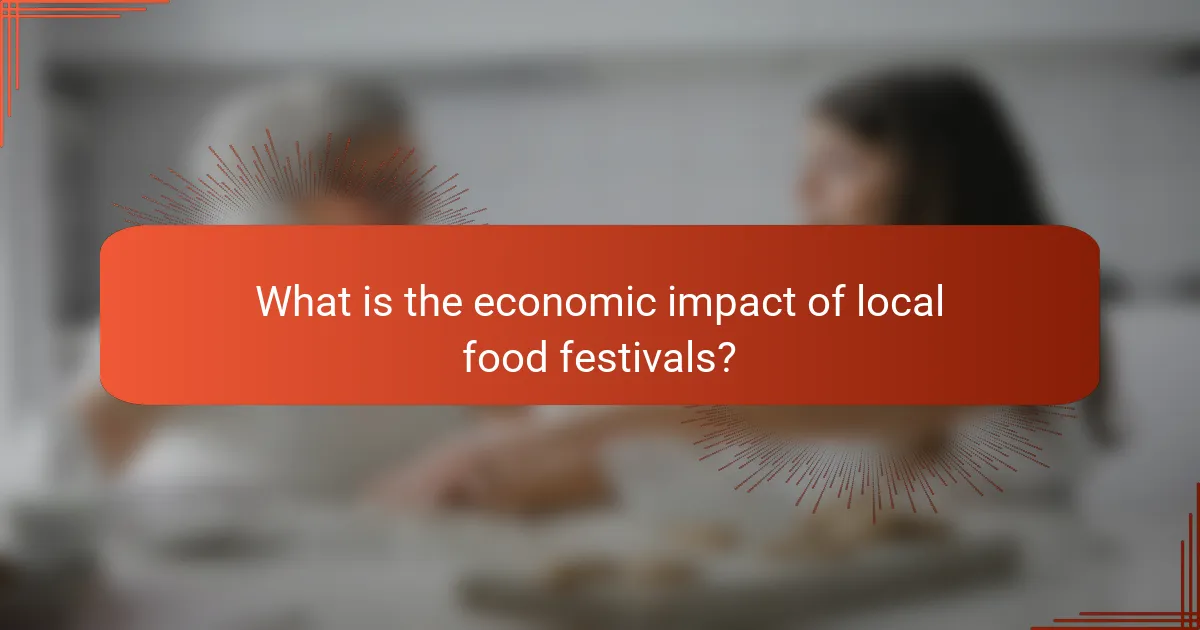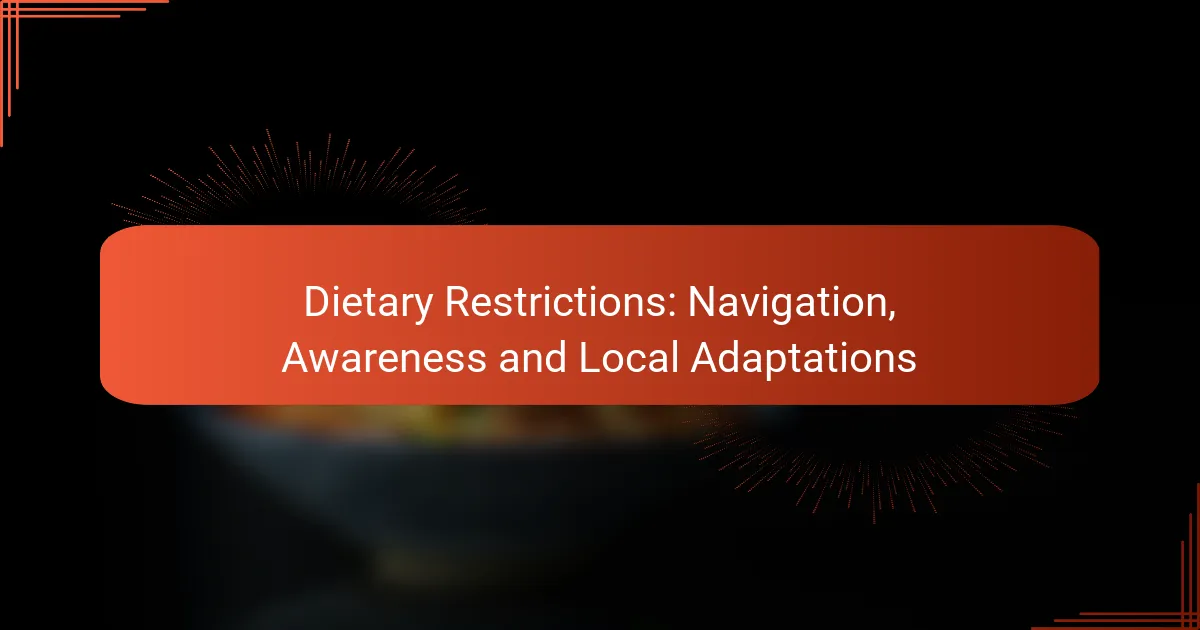Local food festivals play a vital role in enhancing community engagement by uniting residents and visitors in celebration of regional cuisine and culture. These events not only promote local pride and support small businesses but also contribute to economic growth and environmental sustainability through increased awareness of eco-friendly practices.

How do local food festivals enhance community engagement?
Local food festivals enhance community engagement by bringing together residents and visitors to celebrate regional cuisine and culture. These events foster connections among participants, promote local pride, and support small businesses, creating a vibrant community atmosphere.
Fostering local pride
Local food festivals serve as a platform for showcasing regional culinary traditions and ingredients, instilling a sense of pride among community members. By highlighting local specialties, such as traditional dishes or unique food products, festivals encourage residents to appreciate their cultural heritage.
Communities often feature local chefs and home cooks, allowing them to share their skills and stories. This not only elevates local talent but also strengthens the bond between residents and their culinary roots.
Encouraging social connections
Food festivals create opportunities for social interaction, allowing people to meet and connect over shared interests in food and culture. Attendees can engage in conversations, participate in cooking demonstrations, or enjoy communal dining experiences, fostering a sense of belonging.
These events often include activities such as workshops and tastings, which encourage collaboration and networking among participants. By bringing diverse groups together, festivals help break down barriers and promote inclusivity within the community.
Supporting local businesses
Local food festivals provide a significant boost to small businesses by increasing visibility and attracting customers. Vendors, including farmers, food artisans, and restaurants, can showcase their products and services to a larger audience, often leading to increased sales and customer loyalty.
Moreover, festivals can stimulate the local economy by encouraging attendees to explore nearby shops and attractions. This ripple effect supports a range of businesses, from food producers to artisans, contributing to the overall health of the community’s economy.

What is the economic impact of local food festivals?
Local food festivals significantly boost the economy by attracting visitors, increasing vendor sales, and creating job opportunities. These events not only celebrate regional cuisine but also stimulate local businesses and enhance community engagement.
Boosting local tourism
Local food festivals draw tourists who are eager to experience unique culinary offerings, contributing to the local economy. Visitors often spend on accommodations, dining, and entertainment, which can lead to increased revenue for local businesses.
For example, a food festival in a small town might see attendance in the thousands, translating to a substantial influx of cash flow into hotels, restaurants, and shops. This surge can help sustain these businesses throughout the year.
Increasing sales for vendors
Vendors at local food festivals often experience a significant increase in sales during the event. This boost can be attributed to the high foot traffic and the opportunity to showcase their products to a larger audience.
Many vendors report sales increases of 20-50% during festivals compared to regular days. This not only helps them recover costs but can also lead to long-term customer relationships and repeat business.
Creating job opportunities
Local food festivals create temporary and sometimes permanent job opportunities in various sectors, including event management, food service, and logistics. These jobs can range from hiring additional staff for the festival to supporting local suppliers and service providers.
In many cases, festivals can lead to the creation of seasonal positions that help young people and those seeking part-time work gain valuable experience in the hospitality and food industries. This can enhance their employability in the long run.

What are the environmental benefits of local food festivals?
Local food festivals offer significant environmental benefits by promoting sustainable practices, reducing food waste, and encouraging local sourcing. These events create awareness and foster community engagement around eco-friendly food systems.
Promoting sustainable practices
Local food festivals often showcase sustainable farming techniques and environmentally friendly practices. By featuring organic produce and eco-conscious vendors, these events educate attendees about the importance of sustainability in food production.
Workshops and demonstrations at festivals can provide practical tips for consumers on how to support sustainable agriculture, such as choosing seasonal foods or reducing reliance on imported goods. This knowledge empowers individuals to make more informed choices in their daily lives.
Reducing food waste
Food festivals typically emphasize the importance of minimizing waste through various strategies. Many events implement practices such as composting leftover food, which helps divert organic waste from landfills.
Additionally, local food festivals often collaborate with food banks or charities to donate surplus food, ensuring that it reaches those in need rather than being discarded. This not only reduces waste but also strengthens community ties.
Encouraging local sourcing
Local food festivals highlight the benefits of sourcing ingredients from nearby farms and producers. By connecting consumers directly with local growers, these events help to foster a sense of community and support the local economy.
Attendees are often encouraged to buy directly from vendors, which reduces the carbon footprint associated with transporting food over long distances. This practice not only benefits the environment but also ensures fresher produce for consumers.

How can organizers improve local food festival experiences?
Organizers can enhance local food festival experiences by focusing on accessibility, diverse food options, and leveraging technology for engagement. Implementing these strategies can create a more inclusive and enjoyable atmosphere for attendees.
Enhancing accessibility
Improving accessibility at food festivals involves ensuring that all attendees, including those with disabilities, can navigate the venue easily. This can be achieved by providing wheelchair ramps, accessible restrooms, and clear signage throughout the festival grounds.
Organizers should also consider offering sensory-friendly spaces for individuals who may be overwhelmed by crowds or noise. Providing information in multiple formats, such as braille or large print, can further enhance accessibility for all participants.
Incorporating diverse food options
To cater to a wider audience, food festivals should include a variety of culinary options that reflect the local community’s diversity. This can mean featuring cuisines from different cultures, as well as accommodating various dietary preferences, such as vegan, gluten-free, and allergen-friendly choices.
Organizers can collaborate with local chefs and food vendors to showcase unique dishes that highlight regional ingredients. Offering cooking demonstrations or tastings can also engage attendees and promote cultural appreciation.
Utilizing technology for engagement
Technology can play a significant role in enhancing the festival experience through interactive elements. Organizers can use mobile apps to provide real-time updates on schedules, vendor locations, and special events, making it easier for attendees to navigate the festival.
Social media platforms can be leveraged to create buzz before, during, and after the event. Encouraging attendees to share their experiences online can foster community engagement and attract more visitors in the future. Additionally, implementing cashless payment systems can streamline transactions and improve overall efficiency.

What criteria should be considered when selecting a local food festival?
When selecting a local food festival, consider factors such as location, vendor diversity, and community involvement. These elements significantly influence the festival’s accessibility, variety of offerings, and overall engagement with the local population.
Location and accessibility
The location of a food festival plays a crucial role in its success. A central, easily accessible venue can attract more attendees, while remote locations may limit participation. Consider proximity to public transportation and parking availability to ensure convenience for visitors.
Accessibility also includes accommodations for individuals with disabilities. Ensure that the venue complies with local regulations regarding accessibility, providing ramps, seating, and facilities that cater to all attendees.
Vendor diversity
A diverse range of vendors enhances the festival experience by offering various cuisines and food options. Aim for a mix of local restaurants, food trucks, and artisanal producers to appeal to different tastes and dietary preferences.
Consider including vendors that represent various cultural backgrounds. This not only enriches the festival but also fosters community connections and celebrates the area’s culinary heritage.
Community involvement
Community involvement is essential for a successful food festival. Engage local organizations, schools, and volunteers to help with planning and execution. This collaboration can strengthen community ties and ensure the festival reflects local interests.
Encourage local residents to participate by hosting contests, cooking demonstrations, or workshops. This not only boosts attendance but also creates a sense of ownership and pride in the event, ultimately enhancing its impact on the community.

What are the future trends in local food festivals?
Future trends in local food festivals include the integration of virtual experiences and a heightened focus on health and wellness. These trends reflect changing consumer preferences and the need for festivals to adapt to modern lifestyles.
Integration of virtual experiences
Local food festivals are increasingly incorporating virtual experiences to reach a broader audience. This can include live-streamed cooking demonstrations, interactive workshops, and virtual tastings that allow participants to engage from home.
To effectively implement virtual components, organizers should consider platforms that facilitate interaction, such as social media or dedicated event apps. Offering a mix of in-person and online options can enhance accessibility and participation.
Focus on health and wellness
As health consciousness rises, local food festivals are placing greater emphasis on wellness. This includes featuring organic, locally-sourced ingredients and offering healthier food options to cater to diverse dietary needs.
Festivals can enhance their appeal by incorporating wellness activities such as yoga sessions, nutrition workshops, and cooking classes focused on healthy eating. Engaging local health professionals to provide insights can further enrich the festival experience.



